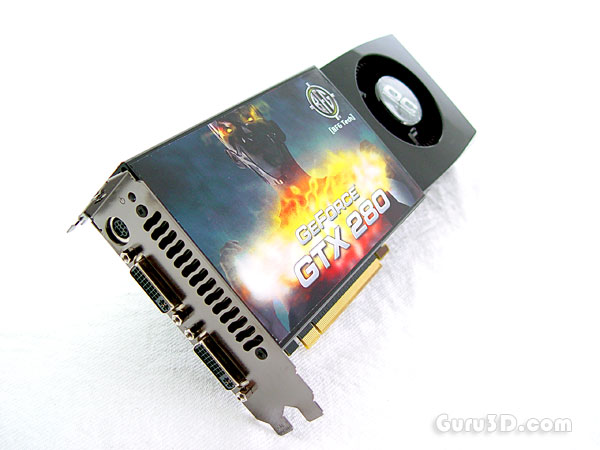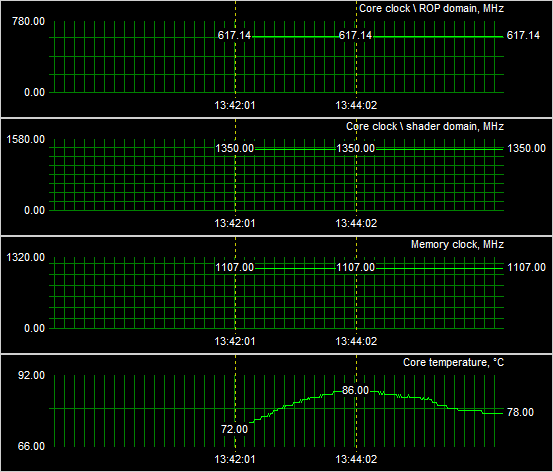4 - GPU temps, power cosumption & noise levels
Testing Power consumption
We'll now show you some tests we have done on overall power consumption of the PC. Looking at it from a performance versus wattage point of view, the power consumption is not as bad as I expected it to be. The card according to NVIDIA has a TDP of roughly 237 Watts.
The methodology is simple: We have a device constantly monitoring the power draw from the PC. After we have run all our tests and benchmarks we look at the recorded maximum peak; and that's the bulls-eye you need to observe as the power peak is extremely important. Bare in mind that you are not looking at the power consumption of the graphics card, but the consumption of the entire PC.
Our test system contains a Core 2 Duo X6800 Extreme Processor, the nForce 680i mainboard, a passive water-cooling solution on the CPU, DVD-rom and a WD Raptor drive. The results:
- PC in Idle = 155 Watt
- PC 100% usage (wattage gaming Peak) = 365 Watt
Opposed to the reference samples we tested, this retail sample had a proper functioning 2D low- p-state. Meaning when the card idles is shut down the core domain to 300 MHz, 100 MHz on the shader and get this .. 200 MHz (effective) on the memory.
The result is an awesome power efficient product as our wattage metered returned 155 Watt, which is the lowest we ever measured on this system.
The monitoring device is reporting a maximum system wattage peak at roughly 365 Watts, and for a PC with this high-end card, that a lot yet not excessive at all.
Recommended Power Supply
So here's my power supply recommendation:
GeForce GTX 260 | 280
- A GeForce GTX 260 requires you to have a 500 Watt power supply unit at minimum if you use it in a high-end system. That power supply needs to have (in total accumulated) at least 38 Amps available on the 12 volts rails.
- A GeForce GTX 280 requires you to have a 550 Watt power supply unit at minimum if you use it in a high-end system. That power supply needs to have (in total accumulated) at least 40 Amps available on the 12 volts rails.
GeForce GTX 260 | 280 SLI
- A second GeForce GTX 260 requires you to have a 700 Watt power supply unit at minimum if you use it in a high-end system. That power supply needs to have (in total accumulated) at least 50 Amps available on the 12 volts rails.
- A second GeForce GTX 280 requires you to have a 800 Watt power supply unit at minimum if you use it in a high-end system. That power supply needs to have (in total accumulated) at least 55 Amps available on the 12 volts rails.
There are many good PSU's out there, please do have a look at our many PSU reviews as we have loads of recommended PSU's for you to check out in there. What would happen if your PSU can't cope with the load?:
- bad 3D performance
- crashing games
- spontaneous reset or imminent shutdown of the PC
- freezes during gameplay
- PSU overload can cause it to break down

Noise Levels coming from the graphics card
When graphics cards produce a lot of heat, usually that heat needs to be transported away from the hot core as fast as possible. Often you'll see massive active fan solutions that can indeed get rid of the heat, yet all the fans these days make the PC a noisy son of a gun. I'm doing a little try out today with noise monitoring, so basically the test we do is extremely subjective. We bought a certified dBA meter and will start measuring how many dBA originate from the PC. Why is this subjective you ask? Well, there is always noise in the background, from the streets, from the HD, PSU fan etc etc, so this is by a mile or two not a precise measurement. You could only achieve objective measurement in a sound test chamber.
The human hearing system has different sensitivities at different frequencies. This means that the perception of noise is not at all equal at every frequency. Noise with significant measured levels (in dB) at high or low frequencies will not be as annoying as it would be when its energy is concentrated in the middle frequencies. In other words, the measured noise levels in dB will not reflect the actual human perception of the loudness of the noise. That's why we measure the dBA level. A specific circuit is added to the sound level meter to correct its reading in regard to this concept. This reading is the noise level in dBA. The letter A is added to indicate the correction that was made in the measurement. Frequencies below 1kHz and above 6kHz are attenuated, where as frequencies between 1kHz and 6kHz are amplified by the A weighting.
|
|||||||||||||||||||||||||||||||||||||||
We tested all cards on dBA levels. Obviously the reference coolers all perform roughly the same. The customized coolers are either louder or softer depending on what they try to achieve.
So in IDLE mode, you will not hear the card. We measure less than 38 DBa coming from the PC.
Gaming with an average title not stressing the GPU too much we can hear the fan a little, we measure roughly 40 DBa.
When we loop 3DMark Vantage for a while the GPU really heats up, as side-effect the fan RPM will go up even higher to dispose heat quicker, the noise-levels are now 44-45 DBa, overall these results are fine, though quite noticeable when the GPU is stressed.
The core temperature
Let's have a look at the temperatures this huge cooler offers.
 |
||
In idle you can expect a temperature of 50 Degrees C. The start results here are a bit weird, yet I had the Folding@Home client crunching data. But again expect an 50 idle temperature.
Once we stress the GPU to 100%, the temperatures take a pretty hefty toll and settle at ~85 Degrees C, that's 185 degrees F.
And that's just really a lot, something I dislike as that's 20 Degrees C away from the 105 C threshold of the GPU jumping into SAFE mode. Please make sure you PC chassis is very well ventilated so you have a good inbound flow of cold air.
